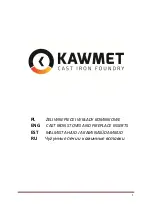
22
To achieve long burn times, after having thoroughly preheated the
stove, load the firebox without blocking the small air opening found
in the center front of the firebox.
At this point, you may need to burn
the stove with the draft open for a few minutes to ignite the wood. All
IHP stoves are EPA tested for emissions at low burn with the air control
completely closed. Whether or not you should burn your stove with the
air control completely closed will depend on the following factors:
•
How you load your wood
•
Your chimney type, height and draft
•
Your wood type and its moisture content
•
The temperature of the appliance
•
Which model stove or insert you have
In order to maximize the burn time of your stove you may need to experi-
ment to get the right balance of starting temperature, wood type, and
draft control setting for your particular venting configuration. Do not
reload the stove for long burns when the stainless secondary tubes or
baffles are glowing red, or when the stove is uncomfortably hot to load.
This indicates the stove is too hot to load for a long burn.
ACHIEVING CLEAN, LONG BURNS
It is important to know that for clean highly efficient burns you will
need to have sufficient temperatures inside the firebox for thorough
combustion
. The best method for determining if you have sufficient
temperatures is to watch the brick lining in your firebox. When you first
light your stove or fireplace insert, the firebrick will turn a dark brown or
black. After 20 to 30 minutes of a hot fire, most of the bricks should return
to near their original beige color. This means the firebrick have reached
a high enough temperature for your stove to achieve high combustion
efficiency and you are ready to adjust the draft control to a lower setting.
Second and just as important, is achieving a high level of heat transfer
efficiency.
Slowing the rate of flow through the stove or insert enhances
heat transfer, thus allowing more time for heat to be transferred into your
home. To do this, be sure to thoroughly preheat your stove and then
reduce the amount of primary air by closing the draft control down to a
lower setting. (More air may produce a slightly greater amount of heat,
but will greatly increase wood consumption).
To get the most out of your appliance, you will need to combine good
combustion efficiency with good heat transfer practices. The following
are some tips on how to operate your stove to achieve the highest overall
efficiency.
1. Thoroughly preheat your stove before slowing the burn rate by closing
the draft control.
2. When loading wood into a preheated stove or fireplace insert, allow
a vigorous fire to build before lowering the draft control.
3. Operate your stove as much as possible in the low to medium burn
ranges.
4. Do not lower the draft setting so low as to completely extinguish the
flames in the firebox. Check for at least some small flames twenty
minutes after setting the draft control.
5. Do not continually operate your stove or fireplace insert in the high
(wide open) setting. This wastes wood by carrying a great deal of
heat up the chimney and can damage your stove or fireplace insert
and chimney.
6. Go outside and check your chimney. More than a very small amount
of smoke indicates wasted heat, creosote build up and pollution
(see
Figure 32
)
.
MAXIMIZING YOUR STOVE’S OVERALL EFFICIENCY
GETTING THE MOST OUT OF YOUR STOVE
Recent developments in wood-burning technology have made wood-
burning a cleaner and more convenient way to heat your home. Overall
efficiency in a wood-burning appliance is a combination of combustion
efficiency and heat transfer efficiency. Whether heating your entire home or
just a room or two, your understanding of how to best operate your stove
or insert will enhance its overall efficiency and performance. What this
can mean to you is longer, cleaner burns, less wood use and more heat.
The following sections will outline techniques you can use to “get the
most out of your stove.” Please read them carefully.













































